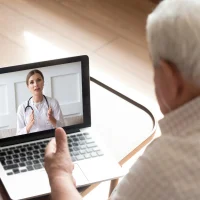During the COVID-19 pandemic, when physical distancing is necessary to help curb virus spread, telemedicine use has risen. A recent JAMA study looks into factors key in directing a patient’s choice of telemedicine use (via video or telephone) versus office visit.
You might also like: China Sees COVID-19 Telehealth Expansion
The study focused on an integrated care delivery system, Kaiser Permanente Northern California, in which patients schedule primary care appointments via an online patient portal. Patients can choose between three visit types with the same primary care clinician: office visit, video visit or telephone visit.
For this study, researchers reviewed data from 1,131, 722 patients who made a total of 2,178,440 scheduled primary care visits between 1 January, 2018 and 31 May, 2019. The data excluded visits for routine physical, which are not telemedicine-eligible.
The result show that patient demographics (age, race/ethnicity, socioeconomic status), access to technology (internet access, mobile portal use), and in-person visit barriers (travel time, parking, cost-sharing) are important factors in choosing between telemedicine and office visits.
The researchers reported these key findings:
- Of the nearly 2.2 million primary care visits, 86% were scheduled as office visits and 14% as telemedicine visits, with 7% of the telemedicine visits conducted by video.
- Older patients (65 years and above) were less likely to choose telemedicine than patients aged 18 to 44 years.
- Patients with easier access to internet services were more likely to choose a video visit than patients whose neighbourhoods had low internet access.
- Patients whose clinic had a paid parking structure were more likely to choose a telemedicine visit than patients whose facility had free parking.
- Patients with high out-of-pocket costs for office visits were more likely to choose a telemedicine visit.
In addition, the study results highlight some fine varieties in preferences of phone or video visits depending on parameters such as ethnicity or income level. For instance, Asian patients were more likely than white patients to choose video visits while black patients were comfortable with both phone and video telemedicine.
Although telemedicine may represent ‘a transformative shift’ in patient-centred convenient healthcare access, the researchers point out that the associations identified in this study may indicate opportunities for engaging non-white patients, patients with lower socioeconomic status, patients with mobile technology access, and those who face barriers to in-person visits.
Source: JAMA
Image credit: monkeybusinessimages
via iStock
References:
Reed ME et al. (2020) Patient Characteristics Associated With Choosing a Telemedicine Visit vs Office Visit With the Same Primary Care Clinicians. JAMA Netw Open 3(6):e205873. doi: 10.1001/jamanetworkopen.2020.5873










